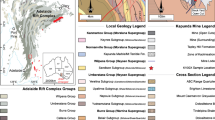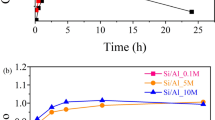Abstract
THE various minerals belonging to the mica group are all characterized by the ease with which they cleave. The reason for this behaviour is found in their structure, which consists in all cases of a double sheet of linked silicon – oxygen tetrahedra of the hexagonal type (Si4O10)1. One in every four silicon ions is replaced by aluminium in most of the natural occurring micas (phlogopite, muscovite, biotite), thus giving the basic AlSi3O10 units; these are firmly bound by the incorporation of aluminium, magnesium and iron ions and hydroxyl groups. The double sheets are weakly linked by potassium ions, and it is along this plane that cleavage takes place. The most important micas conform to the idealized formulæ: Muscovite KAl2 (AlSi3O10)(OH)2 Phlogopite KMg3 (AlSi3O10)(OH)2, but a multitude of substitutions can take place; for example, the magnesium can to some extent be replaced by iron, which gives biotite: K(MgFe)3(AlSi3O10)(OH)2.
Similar content being viewed by others
References
Bragg, W. L., “Atomic Structure of Minerals” (Cornell Univ. Press, 1937).
Middel, V., reported by Curtis, H. A., Chem. and Met. Eng., 109 (March 1946).
Hausman, W., and Krumpell, O., Strahlentherapie, 35, 387 (1930). Tagaki, T., Strahlentherapie, 40, 189 (1931).
Donal, J. S., Rev. Sci. Instr., 13, 266 (1942).
Author information
Authors and Affiliations
Rights and permissions
About this article
Cite this article
POPPER, P. Transmission of Natural and Synthetic Mica in the Ultra-Violet. Nature 168, 1119–1120 (1951). https://doi.org/10.1038/1681119b0
Issue Date:
DOI: https://doi.org/10.1038/1681119b0
- Springer Nature Limited
This article is cited by
-
Transforming ground mica into high-performance biomimetic polymeric mica film
Nature Communications (2018)
-
Transmission of Inidan Mica between 300 and 1,000 mµ and its Visual Classification
Nature (1966)





